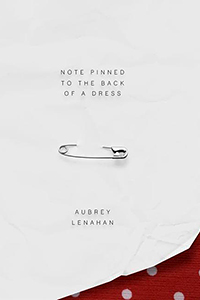 print preview
print previewback EMILIA PHILLIPS
Review | Note Pinned to the Back of a Dress, by Aubrey Lenahan
H_NGM_N Books, 2013
 |
Much like the note on the back of the dress in the chapbook’s title and cover image, Aubrey Lenahan’s poems at times come out of nowhere. We look around for the messenger but see only something darting around a corner, a rustle in the hedges, a footprint on the path. “An artist must sneak,” Lenahan insists. Tom Sleigh, quoting child psychologist D.W. Winnicott, lays out two motivations humans have in creating art: “In the artist of all kinds, one can detect an inherent dilemma . . . the urgent need to communicate and the still more urgent need not to be found.” Language then provides a poet with a “protective camouflage in which to hide,” and like camouflage with its irregularities of pattern, the poems in Note Pinned to the Back of a Dress deny the reader regular forms, including the sentence. Here we find in-line white space and forward slashes, grammatical fragments, absent punctuation, and a multiplicity of voices. Thus, in quoting for review, I’ll transcribe excerpts as they appear in the chapbook so that the spacing within a line and the indentions will retain their intended effect and Lenahan’s use of the backslash won’t be confused with my insertion of a virgule.
Consider “Common Meal,” a poem that exemplifies Lenahan’s experimentation:
what did you know of us before there is the chilled meat in limp petals
chives snipped with scissors how to both take it, and leave it intact
there is no right way to say
I knew you:foreignmine I wanted
to count you among my thingsin old time, we went to stores no we went to the store no
we stored it away: we went to see what we could use now there is so much
to put in the cart to bring to the mouth to rub on the skin
and is there some word for this search
scared, you know want but not whatthe word for perfect accent but no real speech
How many voices interject here? Do we hear one speaker? Two—one in italics, the other in roman? Perhaps a choral speaker? A single speaker imagining hypotheticals? Remembering? Fighting the din of voices? One could argue for any of these possibilities, and perhaps Lenahan intends this temporary ambiguity to enact her very concerns. Throughout the poem, she returns again and again to the binary of knowing/not knowing. Additionally, the binary seems to hinge on speech; moments of knowing/not knowing often appear near or within italicized lines: “for that man there are not answers — that will make a talkings happen / you don’t know a man”; “there is no right way to say / I knew you”; “like is . . . / a word they use for wanting and speaking and not knowing.”
Language, then, provides us with a means to know or not know, to reveal or not reveal—a concept best embodied by a paradox or, perhaps, more literally, a truism: “Other than the noise, it was quiet.” Throughout Note, we find that paradox and negation serve as additional means to distance the poet from the reader: “I sing songs in languages I do not speak”; “make me some animal I am”; “I stock my mind for winter with what you learn / I already know”; “his no eyes”; “Exposed roots tripped no one up that anyone knew.” Lenahan’s use of double negatives forces readers to focus on how the language works; we must pause a moment to interrogate the words for the meaning, thus allowing the poet time to slip away and commit her next poem.
As much as we have considered how Lenahan hides her hand in these poems, a series titled “Entry” provides us with an alternative gesture, the desire to reveal oneself, as in the first installment—“Let us form in a frozen field some pathway to toss our lives upon like fists of salt”—and elsewhere: “Absence will need filling.” Remember Winnicott: even those poets who feel “the need to not be found” must confront the “inherent dilemma,” “the urgent need to communicate.”
Although Lenahan presents the last installment of “Entry” in sentence fragments, it reveals this urgent need:
A Vermont lake and being poor. Back when I wanted what I could name. Bus ride at night with proximity to strangers. The cold plastic of mother’s purse. What we’re after is structure. The lake or its legend, distinguished when mapped. In summer, swimming to where it grows very dark and cold. Kick.
This scene simultaneously contains the speaker, admits loss, and acknowledges old wants: “Back when I wanted what I could name.” Other admissions like this occur in Note, but like the image suggested by the chapbook’s title, we don’t always immediately recognize their presence or significance. It may hide until we look behind us. For this reason, Note deserves multiple readings. We must allow it its meanderings, switchbacks, and screens, its inherent grief—for love, for innocence, for knowledge. Lenahan shows us what’s missing by the holes they leave, their “competing shadows,” so that we can “picture them many times” and provide the “Who what where why when” ourselves. She goads us on: “You are getting close to being close now.” ![]()
![]()
Aubrey Lenahan is the author of Note Pinned to the Back of a Dress (H_NGM_N BOOKS, 2013). Her poems have appeared in Forklift, Ohio, Leveler, The Massachusetts Review, and The Greensboro Review. She teaches creative writing and American literature at the University of Tennessee at Chattanooga.